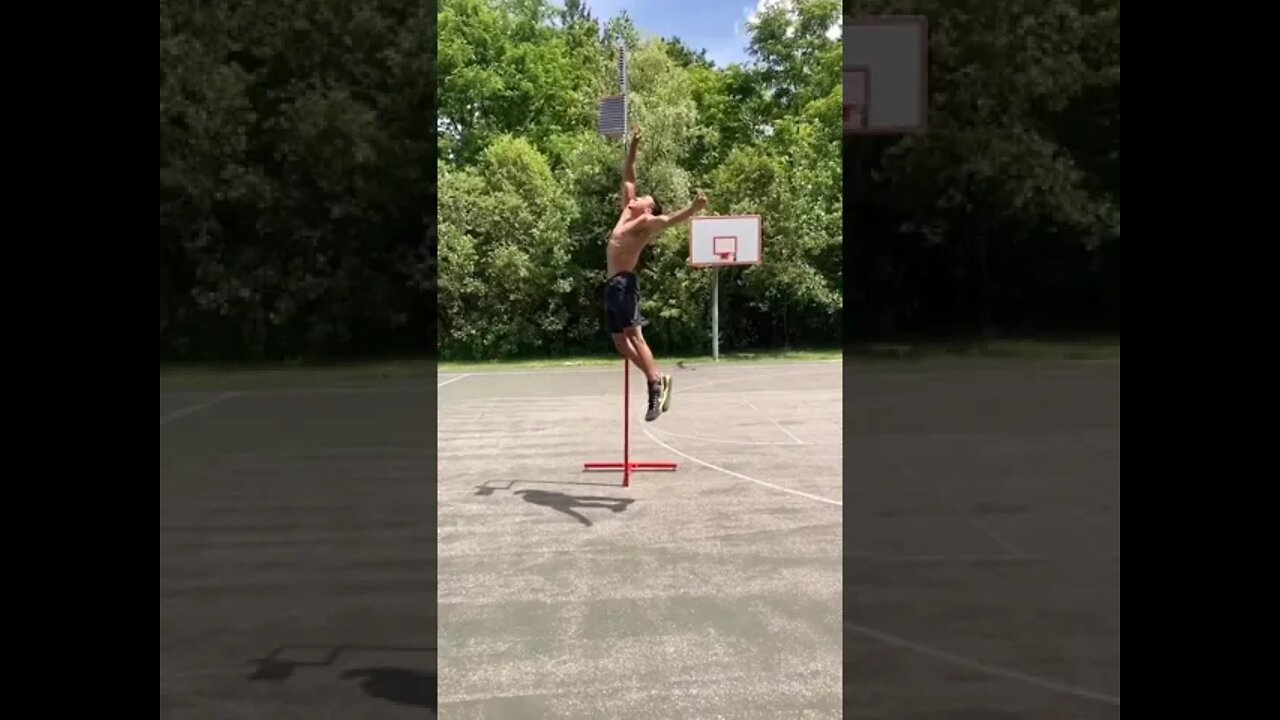Premium Only Content

41 INCH STANDING VERT 🤯🚀 #Shorts
➡️Click ORDER NOW and get started today
https://bit.ly/VerticallJumpTraining
➡️BEST Products To IMPROVE Your Training Performance⤵️
https://bit.ly/JumpHigherr
7 Ways to Improve Your Vertical Jump
To help you get above the rim, we used our own resources and asked Mubarak “Bar” Malik, the director of performance for the New York Knicks, for pointers. He says that “improving vertical leap involves heavy recruitment of the leg muscles, so training should emphasize vertical loaded movements like squats, deadlifts, and Olympic lifts.” And when on the court, follow these tips to perform your max leap each time you drive the lane and go for a slam dunk.
1. Get the knots out of your legs
Muscle knots—also called “trigger points”—are everywhere in your body and restrict the length of your muscle tissue, making them shortened and weaker. Use a foam roller to relieve these spasms, focusing on moving slowly and stopping on tender spots until the knot releases. Work on each of the following areas for at least 30 seconds before switching legs:
Calves: Put the roller under your calf and rest your other foot on the floor (or cross it over the top of your shin to increase pressure). Roll from your ankle to your knee.
IT Band: Lie on your side with the roller near your hip and rest your other foot on the floor. Move the roller along your outer thigh. You can increase pressure by stacking your legs on top of one another.
Quads: Lie on your stomach with the roller placed under the front of your thigh. Roll up and down from the bottom of your hip to the top of your knee.
2. Do Bulgarian split squats
Your legs give you power to jump higher. (Another reason not to neglect your stems!) The Bulgarian split squat will help build strength, while improving your balance. To do it, stand a couple paces away from a bench, and place your non-working leg on it. The top of your foot should be on the bench. Hold a dumbbell in each hand and stand erect with your chest up. Descend until your back knee nearly touches the floor. Using the heel of your lead foot (the one that’s on the floor), push yourself back up into a standing position. That’s one rep. Try doing 3 sets of 8 reps on each leg on your lower-body workout day.
3. Practice depth jumps
A depth jump is performed by stepping off a box, then exploding up immediately after landing on the ground. This teaches reaction time and will help your lower body muscles activate when you need to catch air. Start by standing on a box that’s 6 to 8 inches off the ground. Step off. As soon as you touch the ground, jump as high as you can, reaching your arms overhead. Land softly in an athletic position. Take a second to recover, then step back onto the box, set yourself up, and repeat. Follow this progression:
Week 1: 3×3 reps
Week 2: 4×3 reps
Week 3: 5×3 reps
4. Incorporate knee-to-feet jumps
You’re probably less familiar with this plyometric move: knee-to-feet jumps.
How to do it: Come down to your knees and sit back on your heels. Swing your arms to help create momentum as you explosively jump up, driving your hips forward and bringing your legs and feet directly underneath you. Brace your body as you land in a squat position with your arms out in front of you. Lower back to the kneeling position, coming down on one knee at a time.
This move produces more lower body power, and, when done in tandem with a sport-specific lifting regimen for six weeks, can boost your vertical jump, according to research published ahead of print in the Journal of Strength & Conditioning Research. In the study, 26 college athletes at Truman State University (participating in football, wrestling, softball, basketball, and track) saw improvements when they followed this protocol:
Week 1: Day 1 (test day), Day 2 (6×3 reps), Day 3 (5×4 reps)
Week 2: Day 1 (4×5 reps), Day 2 (3×5 reps), Day 3 (4×4 reps)
Week 3: Day 1 (4×4 reps), Day 2 (4×3 reps), Day 3 (3×3 reps)
Week 4: Day 1 (2×3 reps), Day 2 (3×2 reps), Day 3 (2×2 reps)
Week 5: Day 1 (4×3 reps), Day 2 (4×2 reps), Day 3 (3×2 reps)
Week 6: Day 1 (5×1 reps), Day 2 (4×1 reps), Day 3 (test day)
5. Visualize being like Mike
Meditation and mindfulness can calm your body, which is essential for executing ballistic movements correctly, Malik says. Visualize touching above the rim and flushing the ball.
6. Hang low
To get the feel for dunking right away, practice on a rim lowered to your current jumping ability, Malik suggests. The basket should still require you to jump your highest in order to build up the muscles required to slam.
7. Start with small balls
Begin with a tennis ball, then move up to a softball, then a volleyball, then a youth-size basketball, then a regulation one, Malik says. If you can’t palm it, you’ll have to control the ball with two hands till the last-minute extension for the one-handed dunk. Then it’s time to take Sidney Deane to Sizzler
41 INCH STANDING VERT 🤯🚀 #Shorts .
. .
Link do Video: https://youtu.be/fBAMTzRvBI8
-
 1:05:32
1:05:32
In The Litter Box w/ Jewels & Catturd
23 hours agoShalom Hamas | In the Litter Box w/ Jewels & Catturd – Ep. 756 – 3/6/2025
40.8K8 -
 1:23:00
1:23:00
Sean Unpaved
2 hours ago $1.56 earnedNFL Free Agency
12.5K1 -
 18:25
18:25
Stephen Gardner
1 hour ago🔥The REAL REASON the Epstein Files are being HIDDEN | I CONFRONT Alan Dershowitz for details!
17.2K34 -
 1:58:44
1:58:44
The Quartering
5 hours agoTrump To Charge USAID Staff, Campus RIOT Erupts, Theo Von & Candace Owens, Ukraine Gets Worse!
68.7K30 -
 1:08:42
1:08:42
Winston Marshall
5 hours ago“This Is a Ticking Timebomb!” Trump’s Unlikely Coalition & The Woke Right w/James Lindsay
20.8K5 -
 24:32
24:32
Rethinking the Dollar
5 hours agoWhy Washington Will NEVER Fix the Debt Crisis w/ Paul Stone
8.43K -
 4:40:22
4:40:22
Viss
5 hours ago🔴LIVE - PUBG New Extraction Shooter Coming Soon? - PUBG
28.7K2 -
 51:11
51:11
PMG
19 hours ago $0.22 earnedHannah Faulkner and Chloe Castillo | Is your music IMPACTING you?!
8.04K -
 1:07:36
1:07:36
Russell Brand
6 hours agoTariff War Begins: Trudeau Threatens Retaliation Against Trump – SF549
117K81 -
 1:51:07
1:51:07
vivafrei
5 hours agoGuest "Misfit Patriot" on Andrew Tate & Casey Anthony! Canada Goes Full Trade War! ACB = DEI?
79.3K32